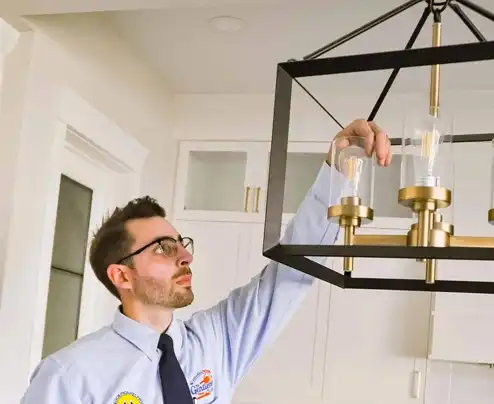Same Day Service
Since 2001
Are you well acquainted with your circuit breakers due to your frequent trips to reset them? As annoying as this is, they are doing their job. However, if tripping breakers are a daily occurrence, they need to be looked at. Circuit breakers not only supply electricity to the different branch circuits in your home, but they are a vital part of your electrical safety system.
“We didn’t know any local electricians, so took a chance on Gentleman Pros. It was a fantastic experience from start to finish, and everyone was helpful and knowledgeable. Our electrician was Colleen and, based on our experience with her alone, we will definitely be looking to Gentleman Pros first whenever we’re looking to get any work done. Highly recommend!” A A

Maintaining your circuit breakers is a good way to maintain your electrical system’s reliability. If you have an older home, replacing your circuit breakers could even improve your system’s reliability.
Signs your circuit breakers need to be replaced or upgraded
Your days are jam-packed and the last thing we want to do is add to it. So don’t, give us a call and let us take care of it for you.
Our dependable and honest electricians are experts in all things electrical. Including circuit breaker problems. We trust our electricians so much that we have a 100% customer satisfaction guarantee. If the work is not done to local, provincial, and national guidelines, we will refund your money.
If you are worried, even a tiny bit, about your circuit breakers, let us know. Our attentive customer service agents can be reached by phone at (780) 628-1734 or online by filling out the online form or clicking on the red Chat With Us button in the lower right corner of the page.
We’ve mentioned that one of the jobs circuit breakers do is detect a problem in the circuit and immediately turn off electricity to that circuit when there is a problem. But how do they do this?
Before we get into the explanation, here are a few terms and concepts you need to know.
Branch Circuit – the electrical service to a specific part of the house. Each circuit breaker services one branch circuit. It’s called this because it “branches” off the main electrical service.
Hot Wire – carries the electricity from the electrical panel through the circuits to the outlets, switches, fixtures, appliances, etc. on the branch circuit.
Neutral Wire – carries the electricity from the outlets, switches, fixtures, appliances, etc. on the branch circuit back to the electrical panel. It completes the loop electricity needs to operate.
Neutral Bus Bar – The neutral wires connect to the neutral bus bar in the electrical panel. From here the electricity travels back to its source, which is the grid, completing its circuit.
Bond/Ground Wire – a safety wire that connects conductive but non-current carrying parts of the circuit plus a few other things to each other. It provides a safe path for errant electricity back to the electrical panel.
Grounding Bus Bar – The bond wire connects to the grounding bus bar in the electrical panel. From here the “escaped” electricity travels back to its source, whether the source is the grid or the ground.
Electricity works in a circuit and always travels back to its source. In our homes, the electricity enters our homes through the electric meter and into the electrical panel. From here, the circuit consists of the hot wire carrying the electricity out from the electrical panel to the items on its circuit and the neutral wire carrying the electricity back to the panel. From the panel, the electricity exits our home through the electric meter back to the grid (the electricity’s source).
Because the electricity is running on one continuous loop, the electrical current (amperage) should be the same along the entire loop. Meaning the amperage should be exactly the same on the neutral wire as it is on the hot wire. In practice, this can get more complicated. But on a typical residential branch circuit, the amperage on the hot and neutral wires should be the same.
A branch circuit’s hot wire is attached to a standard circuit breaker and then travels through the circuit. Its neutral wire comes back from the circuit and attaches to the neutral bus bar, and its bond wire is attached to all the bonded items in the circuit and then travels back to the electrical panel and attaches to the grounding bus bar.
A circuit breaker is designed to detect amperage over a set amount. When it detects this excess amperage, it opens the circuit, or as most people say, it trips, turning off the electricity to the entire branch circuit.
But if electricity works in a loop and only the hot wire is attached to the circuit breaker, how does the circuit breaker know if there is a problem with the neutral wire?
When there is low resistance in the neutral wire carrying the electricity back to the electrical panel, a very high current measured in amps (amperage) is generated. And because electricity works in a loop (circuit) what is happening on the neutral wire is also happening on the “hot” wire.
As a result, the hot wire which is attached to the circuit breaker will also have low resistance and a high current. The circuit breaker detects the problem and if the current’s amperage exceeds its capacity, the breaker will trip.
A conventional circuit breaker has a switch that controls the flow of electricity. It is either activated by an electromagnet or a bimetallic switch.
When the switch is on in an electromagnetic circuit breaker, it allows electricity to flow through the magnetic and out to the branch circuit. The electricity charges the magnet and magnetizes it.
The lower the current’s amperage, the lower the magnetic charge. The higher the amperage the stronger the charge. And when the amperage exceeds the safe amount, the magnet’s charge becomes so strong that it pulls on the switch’s linkage, moving the switch to its off position which stops the flow of electricity to the branch circuit.
The concept is the same with a bimetallic breaker. But instead of a magnet, it uses a bimetallic strip. The two metals in the strip expand at different levels when the strip is heated.
The electric current runs through the bimetallic strip. As amperage increases, so does heat. When the current exceeds the safe amperage level, the heat the amperage generates is enough to bend the strip. The bending of the strip turns the switch off which turns the electricity off.
The strip bends because the two metals are expanding at different rates. The metal that expands the most rapidly will bend the strip to its side.
There are more advanced circuit breaker designs and we discuss them here.
This article delves more deeply into how circuit breakers work.



